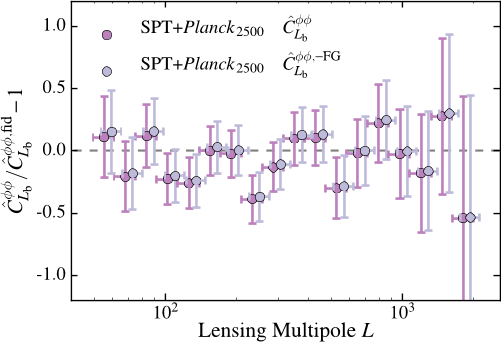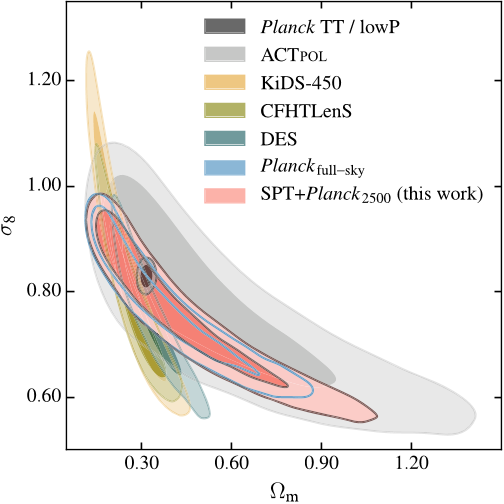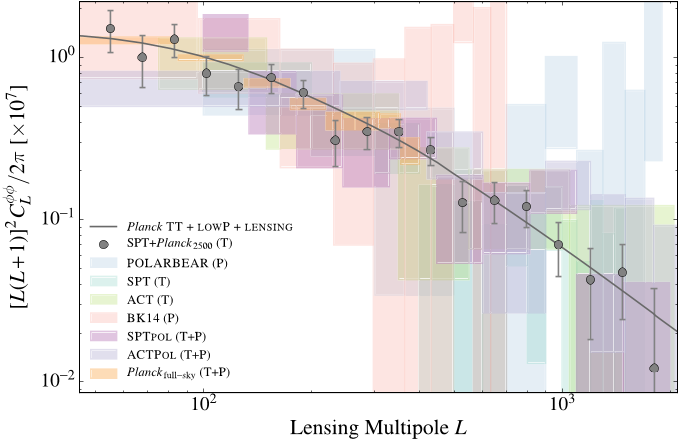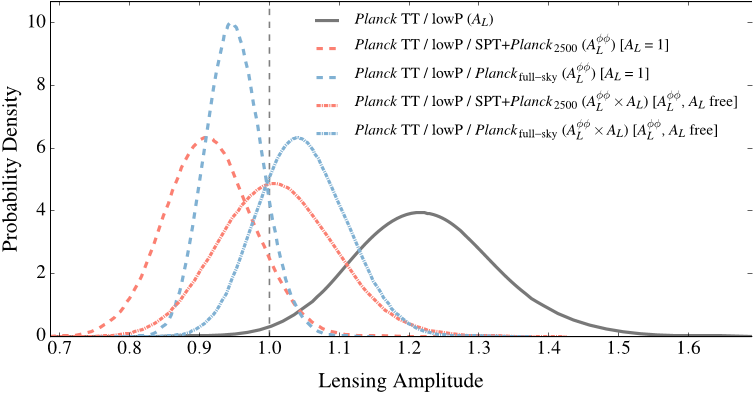
Lawrence Berkeley National Laboratory
Recent Work
Title
Constraints on Cosmological Parameters from the Angular Power Spectrum of a Combined
2500 deg
2
SPT-SZ and Planck Gravitational Lensing Map
Permalink
https://escholarship.org/uc/item/3fz895wq
Journal
Astrophysical Journal, 860(2)
ISSN
0004-637X
Authors
Simard, G
Omori, Y
Aylor, K
et al.
Publication Date
2018-06-20
DOI
10.3847/1538-4357/aac264
Peer reviewed
eScholarship.org Powered by the California Digital Library
University of California

Constraints on Cosmological Parameters from the Angular Power Spectrum of a
Combined 2500 deg
2
SPT-SZ and Planck Gravitational Lensing Map
G. Simard
1
, Y. Omori
1,2,3
, K. Aylor
4
, E. J. Baxter
5,6,7
, B. A. Benson
6,7,8
, L. E. Bleem
6,9
, J. E. Carlstrom
6,7,9,10,11
,
C. L. Chang
6,7,9
, H-M. Cho
12
, R. Chown
1
, T. M. Crawford
6,7
, A. T. Crites
6,7,13
, T. de Haan
1,14
, M. A. Dobbs
1,15
,
W. B. Everett
16
, E. M. George
14,17
, N. W. Halverson
16,18
, N. L. Harrington
14
, J. W. Henning
6,9
, G. P. Holder
1,15,19,20
,
Z. Hou
6,7
, W. L. Holzapfel
14
, J. D. Hrubes
21
, L. Knox
4
, A. T. Lee
14,22
, E. M. Leitch
6,7
, D. Luong-Van
21
, A. Manzotti
6,7
,
J. J. McMahon
23
, S. S. Meyer
6,7,10,11
, L. M. Mocanu
6,7
, J. J. Mohr
24,25,26
, T. Natoli
6,10,27
, S. Padin
6,7
, C. Pryke
28
,
C. L. Reichardt
14,29
, J. E. Ruhl
30
, J. T. Sayre
16,30
, K. K. Schaffer
6,11,31
, E. Shirokoff
6,7,14
, Z. Staniszewski
30,32
, A. A. Stark
33
,
K. T. Story
2,3,6,10
, K. Vanderlinde
27,34
, J. D. Vieira
19,20
, R. Williamson
6,7
, and W. L. K. Wu
6
1
Department of Physics and McGill Space Institute, McGill University, Montreal, Quebec H3A 2T8, Canada; gholder@illinois.edu
2
Kavli Institute for Particle Astrophysics and Cosmology, Stanford University, 452 Lomita Mall, Stanford, CA 94305, USA
3
Dept. of Physics, Stanford University, 382 Via Pueblo Mall, Stanford, CA 94305, USA
4
Department of Physics, University of California, Davis, CA 95616, USA
5
Center for Particle Cosmology, Department of Physics and Astronomy, University of Pennsylvania, Philadelphia, PA 19104, USA
6
Kavli Institute for Cosmological Physics, University of Chicago, Chicago, IL 60637, USA
7
Department of Astronomy and Astrophysics, University of Chicago, Chicago, IL 60637, USA
8
Fermi National Accelerator Laboratory, MS209, P.O. Box 500, Batavia, IL 60510, USA
9
High Energy Physics Division, Argonne National Laboratory, Argonne, IL 60439, USA
10
Department of Physics, University of Chicago, Chicago, IL 60637, USA
11
Enrico Fermi Institute, University of Chicago, Chicago, IL 60637, USA
12
SLAC National Accelerator Laboratory, 2575 Sand Hill Road, Menlo Park, CA 94025, USA
13
California Institute of Technology, Pasadena, CA 91125, USA
14
Department of Physics, University of California, Berkeley, CA 94720, USA
15
Canadian Institute for Advanced Research, CIFAR Program in Cosmology and Gravity, Toronto, ON, M5G 1Z8, Canada
16
Center for Astrophysics and Space Astronomy, Department of Astrophysical and Planetary Sciences, University of Colorado, Boulder, CO 80309, USA
17
European Southern Observatory, Karl-Schwarzschild-Straße 2, D-85748 Garching, Germany
18
Department of Physics, University of Colorado, Boulder, CO 80309, USA
19
Astronomy Department, University of Illinois at Urbana-Champaign, 1002 W. Green Street, Urbana, IL 61801, USA
20
Department of Physics, University of Illinois Urbana-Champaign, 1110 W. Green Street, Urbana, IL 61801, USA
21
University of Chicago, Chicago, IL 60637, USA
22
Physics Division, Lawrence Berkeley National Laboratory, Berkeley, CA 94720, USA
23
Department of Physics, University of Michigan, Ann Arbor, MI 48109, USA
24
Faculty of Physics, Ludwig-Maximilians-Universität, D-81679 München, Germany
25
Excellence Cluster Universe, D-85748 Garching, Germany
26
Max-Planck-Institut für extraterrestrische Physik, D-85748 Garching, Germany
27
Dunlap Institute for Astronomy & Astrophysics, University of Toronto, 50 St George St, Toronto, ON, M5S 3H4, Canada
28
Department of Physics, University of Minnesota, Minneapolis, MN 55455, USA
29
School of Physics, University of Melbourne, Parkville, VIC 3010, Australia
30
Physics Department, Center for Education and Research in Cosmology and Astrophysics, Case Western Reserve University, Cleveland, OH 44106, USA
31
Liberal Arts Department, School of the Art Institute of Chicago, Chicago, IL 60603, USA
32
Jet Propulsion Laboratory, California Institute of Technology, Pasadena, CA 91109, USA
33
Harvard-Smithsonian Center for Astrophysics, Cambridge, MA 02138, USA
34
Department of Astronomy & Astrophysics, University of Toronto, 50 St George St, Toronto, ON, M5S 3H4, Canada
Received 2017 December 28; revised 2018 April 19; accepted 2018 May 1; published 2018 June 20
Abstract
We report constraints on cosmological parameters from the angular power spectrum of a cosmic microwave
background (CMB) gravitational lensing potential map created using temperature data from 2500 deg
2
of South
Pole Telescope (SPT) data supplemented with data from Planckin the same sky region, with the statistical power
in the combined map primarily from the SPT data. We fit the lensing power spectrum to a model including cold
dark matter and a cosmological constant (
LCDM
), and to models with single-parameter extensions to
LCDM
.We
find constraints that are comparable to and consistent with those found using the full-sky PlanckCMB lensing
data, e.g.,
s
W
8
m
0.2
5
=0.598±0.024 from the lensing data alone with weak priors placed on other parameters.
Combining with primary CMB data, we explore single-parameter extensions to
LCDM
.Wefind
W=
k
-
-
+
0.012
0.023
0.021
or
n
M
<0.70 eV at 95% confidence, in good agreement with results including the lensing potential as
measured by Planck. We include two parameters that scale the effect of lensing on the CMB:
A
L
, which scales the
lensing power spectrum in both the lens reconstruction power and in the smearing of the acoustic peaks, and
f
f
A
,
which scales only the amplitude of the lensing reconstruction power spectrum. We find
f
f
A
×
A
L
=1.01±0.08
for the lensing map made from combined SPT and Planckdata, indicating that the amount of lensing is in excellent
agreement with expectations from the observed CMB angular power spectrum when not including the information
from smearing of the acoustic peaks.
Key words: cosmic background radiation – cosmological parameters – gravitational lensing: weak
The Astrophysical Journal, 860:137 (9pp), 2018 June 20 https://doi.org/10.3847/1538-4357/aac264
© 2018. The American Astronomical Society. All rights reserved.
1

1. Introduction
Gravitational lensing of the cosmic microwave background
(CMB) has emerged as a useful cosmological tool. CMB
lensing, which probes all structure along a given line of sight,
provides complementary information to the primary CMB
fluctuations which measure structure at z∼1100. The
sensitivity of CMB lensing peaks at intermediate redshifts
(z∼3), making it complementary to large-scale structure
surveys, the sensitivity of which typically peaks at lower
redshifts, and with very different sources of possible systematic
errors. Lensing of the CMB was first detected in cross-
correlation with galaxies a decade ago (Smith et al. 2007); high
signal-to-noise internal detections have now been achieved by
many experiments (Das et al. 2011b; van Engelen et al. 2012;
Planck Collaboration 2014b; POLARBEAR Collaboration
2014; BICEP2 Collaboration et al. 2016). For a review of
CMB lensing, see Challinor & Lewis (2005).
The fluctuations in the CMB lensing potential form a nearly
Gaussian projected field on the sky, with statistical properties
determined by the geometry and the history of structure
formation in the universe. Because the field is nearly Gaussian,
essentially all the information is encoded in the angular power
spectrum. The most precise CMB lensing power spectrum
measurements to date are from the Planckexperiment (Planck
Collaboration 2016b).
Cosmological parameter fits that include CMB lensing
information are broadly consistent with expectations from the
primary CMB measurements alone (Planck Collaboration
2016a). There are, however, mild but interesting tensions
(∼2σ) between constraints on cosmology from Planckprimary
CMB measurements and other cosmological probes. Specifi-
cally related to lensing, the amplitude of the matter power
spectrum on galaxy scales (σ
8
) inferred from Planckprimary
CMB data is slightly higher than that determined from cosmic
shear measurements (Hildebrandt et al. 2017; Joudaki et al.
2017; Troxel et al. 2017). Further, specifically related to
lensing of the CMB, the amount of lensing inferred from
the measured smearing of the acoustic peaks is higher than
that inferred from the direct measurement of the lensing-
induced mode-coupling (Planck Collaboration 2016a). The
amplitude of lensing is expected to be a powerful probe of
neutrino masses (Abazajian et al. 2015), so discordance in
measurements of lensing amplitudes is important for under-
standing the utility of these measurements as probes of particle
physics.
This paper is a companion to Omori et al. (2017), referred to
as O17 hereafter. In that work, we obtained a CMB temperature
map by combining 150 GHz SPT and 143 GHz Planckdata in
the 2500deg
2
South Pole Telescope (SPT)-SZ survey region,
and we used the resulting temperature map to produce a map of
the projected gravitational lensing potential. In this paper, we
present a cosmological parameter analysis of the CMB lensing
power spectrum derived in O17. This spectrum is shown in
Figure 1, along with other recent measurements, including the
full-sky Plancklensing power spectrum.
This work is divided as follows: in Section 2 we review
gravitational lensing of the CMB and reconstruction of the
lensing potential; in Section 3 we describe the CMB
temperature data and simulations used for the O17 analysis
and for this work; in Section 4 we describe how the lensing
likelihood is constructed, including linear corrections for the
unknown true CMB and lensing potential power spectra; in
Section 5 we present the primary result of this paper:
constraints on cosmological parameters; we close with a
discussion.
Throughout this work, we use the Planck
TT + LOWP +
LENSING
cosmology
35
(Planck Collaboration 2016a) as a
fiducial model. This fiducial cosmology is used for generating
the simulated data necessary for the lensing reconstruction. All
CMB temperature and lensing potential power spectra used in
the present analysis have been computed with the
CAMB
Boltzmann code
36
(Lewis et al. 2000).
2. Lensing Reconstruction Framework
In this section, we build the theoretical framework for the
lensing likelihood, presenting selected elements from the
lensing reconstruction pipeline. A more complete description
of the procedure can be found in O17.
2.1. Lensing of CMB Temperature Fluctuations
Gravitational lensing remaps CMB fluctuations in position
space (Lewis & Challinor 2006):
f=+(
ˆ
)(
ˆ
(
ˆ
)) ( )nnnTT ,1
LU
where
f
(
ˆ
)n
is the projected gravitational lensing potential and
superscripts L and U refer to the lensed and unlensed
temperature fields respectively. To gain intuition, Equation (1)
can be Taylor expanded as
f=++¼(
ˆ
)(
ˆ
)·(
ˆ
)()nn nTT T .2
LU U
From the second term, it can be seen that the observed lensed
temperature has a component that is the gradient of the
unlensed field modulated by the lensing deflection ∇f .Ifwe
transform to harmonic space, Equation (2) would have the
second term on the right-hand side written as a weighted
convolution of the temperature field and the lensing potential,
where the harmonic transform for any particular mode for the
lensed field could involve a sum over all of the modes of the
unlensed field. Lensing thus introduces non-zero off-diagonal
elements in the covariance of observed temperature fields in
harmonic space (Okamoto & Hu 2003):
å
f
Dá ñ
=-
-
f
⎛
⎝
⎜
⎞
⎠
⎟() ()
TT
ℓℓ L
mm M
W1,3
ℓm ℓm
LM
M
ℓℓL
LM
12
12
11 2 2
12
where T
ℓm
are the spherical harmonic expansion coefficients of
the temperature fields and f
LM
the coefficients of the projected
lensing potential. The weight
p
=-
+++
´
+-
-
´+++«
f
++
⎜⎟
⎛
⎝
⎜
⎞
⎠
⎟
⎛
⎝
⎞
⎠
()( )()
()
()()( ) ()
W
ℓℓ L
C
ℓℓ L
LL ℓ ℓ ℓ ℓ
212 121
4
11
2
10 1
11 4
ℓℓL
ℓ
TT
ℓℓL
12
12
11 1 2
12
1
12
characterizes the mode coupling induced by lensing (i.e., the
effect of the convolution in Equation (2)).
35
base_plikHM_TT_lowTEB_lensing.
36
http://camb.info (2016 May version).
2
The Astrophysical Journal, 860:137 (9pp), 2018 June 20 Simard et al.

2.2. Lensing Map Reconstruction
The lensing potential can be estimated from observed CMB
maps by measuring the lensing-induced mode coupling of
Equation (3) between pairs of modes in the observed
temperature field (Zaldarriaga & Seljak 1999; Hu & Okamoto
2002). In general, it is best to use pairs in harmonic space that
have good signal-to-noise for measuring lensing. For this
purpose, it is useful to work with a filtered map:
º
¯
TFT
ℓm ℓm ℓm
,
with the filter
º+
-
()FCN
ℓm ℓ ℓm
1
for a given CMB power
spectrum C
ℓ
and an anisotropic (m-dependent) noise power
spectrum N
ℓm
.
A formally optimal estimator (at first order) which
maximizes signal to noise in the estimated lensing potential
(Hu & Okamoto 2002) is
å
f
=
-
-
f
⎛
⎝
⎜
⎞
⎠
⎟
¯
()
()
ℓℓ L
mm M
WTT
1
2
.5
LM
M
ℓm
ℓm
ℓℓL
ℓm ℓm
,
,
12
12
11
22
12
11 2 2
We use Equation (5) as our f estimator for this analysis.
There are other choices (e.g., Namikawa et al. 2013) for how to
weight the mode pairs that sacrifice some signal-to-noise but
reduce foreground contamination. Lensing reconstruction is
done with the
QUICKLENS code.
37
The relationship between the filtered estimate of the lensing
potential resulting from Equation (5) and the true potential can
be written as
ffº
f
¯
(),6
LM LM LM
defining a response function
LM
that in general depends on
both L and M. As outlined in O17, this response function has
been calibrated using simulations. We estimate it by measuring
the cross-spectrum of simulated lensing potential outputs with
the input lensing potential maps and normalizing by the
autospectrum of the inputs.
The true amplitude of mode coupling in the CMB
temperature field induced by lensing is sensitive to the true
(unknown) temperature power spectrum, as can be seen in
Equations (3) and (4). What is measured in the data is some
amount of mode coupling; to turn this into an estimate of the
amplitude of the lensing potential, an assumption is made about
the typical amplitudes of the modes being coupled. The
response function thus depends on the assumed cosmological
parameters. To explore this cosmological dependence, we use
an isotropic approximation to the full anisotropic response
function and its dependence on cosmology. In the case where
both the signal and noise are isotropic (i.e., the CMB signal and
noise only depend statistically on ℓ and not m), the response
function can be written as
å
=
+
fff
()
L
WWFF
1
21
,7
L
ℓℓ
ℓℓL
t
ℓℓL
f
ℓℓ
,
,,
12
12 12
12
where we have indicated extra superscripts on the weight
functions for either the true amount of mode coupling (t) or the
assumed amount for our fiducial cosmology ( f ). The filters F
ℓ
are calculated for the fiducial cosmology. We use Equation (7)
and its dependence on cosmology to determine the cosmology-
dependent corrections to the simulation-based response
function.
The survey mask, point source mask, and spatially varying
noise all violate statistical stationarity in the data, and
consequently they introduce mode coupling that can bias the
lensing reconstruction. The result is that the lensing reconstruc-
tion has a non-zero mean signal—even in the absence of true
lensing signal—that depends on the survey geometry, mask,
and noise properties. This mean field
f
¯
LM
M
F
is calculated using
simulations and removed.
Figure 1. SPT + Plancklensing bandpowers from O17 along with earlier lensing estimates from the SPT-SZ survey (van Engelen et al. 2012) and recent lensing
bandpowers obtained from temperature and polarization measurements from
SPT
POL
(Story et al. 2015). Also plotted are the most recent lensing autospectrum
measurements from
BICEP2+KECK ARRAY (BICEP2 Collaboration et al. 2016), Planck(Planck Collaboration 2016b), POLARBEAR (POLARBEAR
Collaboration 2014) and
ACT
POL
(Sherwin et al. 2017), and a prediction for the lensing power spectrum using the best-fit cosmological parameters from the
Planck
TT + LOWP + LENSING cosmology (Planck Collaboration 2016a).
37
http://github.com/dhanson/quicklens
3
The Astrophysical Journal, 860:137 (9pp), 2018 June 20 Simard et al.

After removing the mean field and correcting for the
response function, the final estimate of the lensing potential is
f
ff
=
-
f
ˆ
¯¯
().8
LM
LM
LM
LM
MF
2.3. Lensing Autospectrum Estimation
To estimate the angular power spectrum of the CMB lensing
map obtained in the previous section, we multiply the estimate
f
ˆ
by the survey mask (including point source and galaxy
cluster masking) and use PolSpice
38
(Szapudi et al. 2001;
Chon et al. 2004) to compute the spectrum of the masked map.
The resulting power spectrum is a biased estimate of the true
lensing power spectrum. Known sources of bias include a
straightforward noise bias,
()
N
L
0
, that comes from taking an
autospectrum of data with noise in it (where “noise” here
includes the Gaussian part of the CMB temperature field and
any other sky signal), and a bias that arises from ambiguity in
exactly which lensing modes are being measured in the power
spectrum,
()
N
L
1
(Kesden et al. 2003). The superscript denotes
the order of the lensing power spectrum involved:
()
N
L
0
is
independent of the true lensing power and only depends on the
instrument noise and sky power, while
()
N
L
1
has a linear
dependence on the lensing power. As detailed in O17,we
calculate these biases using simulations and subtract them from
the measured power spectrum
=--
ff
ff
ˆ
()
ˆˆ
() ()
CCNN.9
L
LLL
01
We use a realization-dependent
()
N
L
0
estimate that takes into
account the power in the particular realization but does not
depend on the assumed cosmology (Namikawa et al. 2013).
The
()
N
L
1
bias depends linearly on the lensing power and will
therefore depend on cosmological parameters. In the flat-sky
limit (Kesden et al. 2003; Das et al. 2011b; Planck
Collaboration 2014b) and assuming isotropic noise and
filtering, the bias is
òò
pp
=
´
´--
+--
ff
ff
ff
ff
ff
ff
-
-
() ()
() ()
[()()
()()] ()
()
∣∣
∣∣
ℓℓ
ℓℓ ℓℓ
ℓℓ ℓ ℓ
ℓℓ ℓ ℓ
N
dd
FFFF W W
CW W
CW W
1
22
,,
,,
,,,10
ℓℓ
ℓℓ
L
LL
ℓℓℓℓ
ff
tt
tt
1
2
1
2
2
3
2
,
12
,
34
,
13
,
24
,
14
,
23
123 4
13
14
where the weight
f
()ℓℓ
W
,
12
is the flat-sky version of
Equation (4).
There is a dependence on both the true CMB power (just as
for
f
L
) and the lensing power. To explore this cosmological
dependence (below), we will use Equation (10) to determine
the cosmology-dependent corrections to the
()
N
L
1
that is derived
from simulations.
The next-order
()
N
L
2
bias is largely removed by using the
lensed theory temperature power spectrum rather than the
unlensed spectrum when constructing the lensing estimator
(Hanson et al. 2011). There are other biases, such as the
()
N
L
32
bias ( Böhm et al. 2016), which are small at the precision of the
current work, and will be neglected.
We estimate uncertainties on the lensing power spectrum by
averaging over N
s
=198 simulations:
å
D=
-
-á ñ
ff ff ff
=
(
ˆ
)(
ˆˆ
)()C
N
CC
1
1
.11
L
s
i
N
Li L
N
2
1
;
2
s
s
This procedure could be used to generate a full covariance
matrix, but for this analysis we assume that uncertainties are
uncorrelated between bins. This is expected for the relatively
large bins that we use and the realization-dependent removal of
the
()
N
L
0
bias that strongly reduces the off-diagonal elements
of the covariance matrix ( Schmittfull et al. 2013). From
simulations, we measured the correlation between bins to be no
more than 5%.
3. Lensing Data
The binned CMB lensing angular power spectrum (or
“lensing bandpowers”)
f
f
ˆ
C
L
b
computed in O17, using the
methods described in that work and summarized in the
previous section, is shown in Figure 1 (along with other recent
measurements from the literature), and the bin ranges and
bandpower values and uncertainties are listed in Table 1.
39
We
will hereafter refer to this as the “
SPT + Planck” lensing
measurement.
The higher angular resolution of the SPT greatly increases the
lensing signal-to-noise per pixel over Planckfrom the larger
number of available small-scale modes which can be used
for measuring the lensing-induced mode coupling. Combining
the Planckand SPT temperature maps strongly reduces the
uncertainties, in particular on small scales (higher L) as
compared to using only the SPT data. This happens because
the lensing map only uses modes in the temperature map
extending to ℓ=3000, to minimize possible foreground
contamination. The high-L lensing modes require probing
correlations in the temperature angular modes that are widely
separated in harmonic space. By using the Planckdata to
recover the low-ℓ modes, there is an increased number of large-
separation mode pairs.
As shown in O17, the
SPT + Planckmeasurements over
the 2500 deg
2
SPT-SZ survey area are more precise than the
Planck-only full-sky constraints for L1000. From the
relative sky coverage, the Planck-only uncertainties using only
the SPT region would be more than three times larger than the
Planck-only full-sky constraints. The combined
SPT +
Planckmeasurements are thus nearly statistically independent,
adding substantial new information.
Small-scale lensing measurements are most susceptible to
foreground contamination, as shown in van Engelen et al.
(2014). In that work, it was found that foreground contamina-
tion increased dramatically beyond L∼2000 for CMB map
filtering choices similar to those adopted in O17. For the
cosmological parameter estimation in this work, we therefore
use the
SPT + Plancklensing measurements only below
L=2000.
A comparison of the O17 bandpowers with the prediction
from the best-fit Planckcosmology is shown in Figure 2. The
ratio is shown with and without a correction for foreground
contamination, based on van Engelen et al. (2014). The
estimated contamination is small, never exceeding more than
5% of the uncertainty in any L bin, but not completely
38
http://www2.iap.fr/users/hivon/software/PolSpice
39
https://pole.uchicago.edu/public/data/simard18
4
The Astrophysical Journal, 860:137 (9pp), 2018 June 20 Simard et al.





